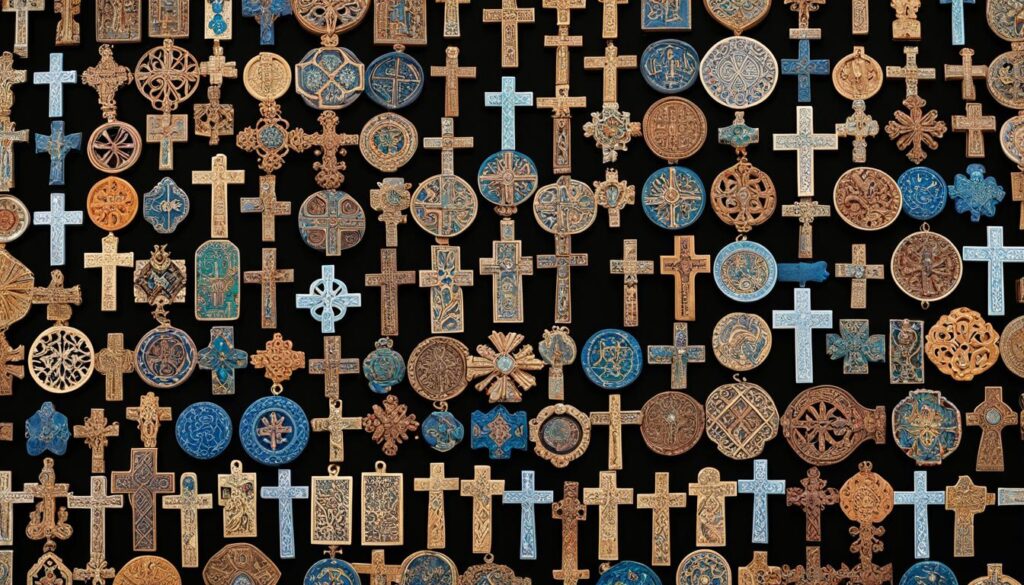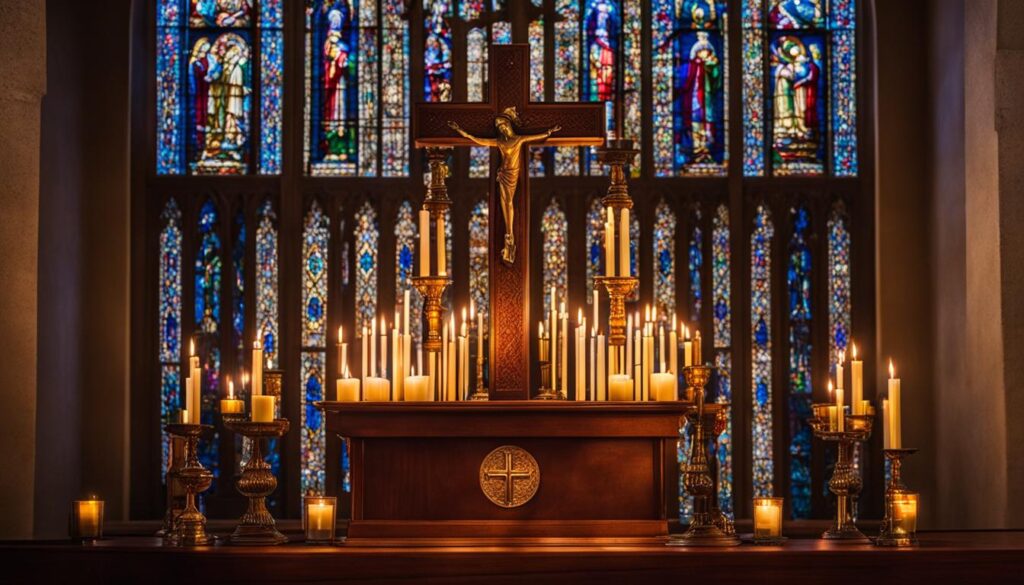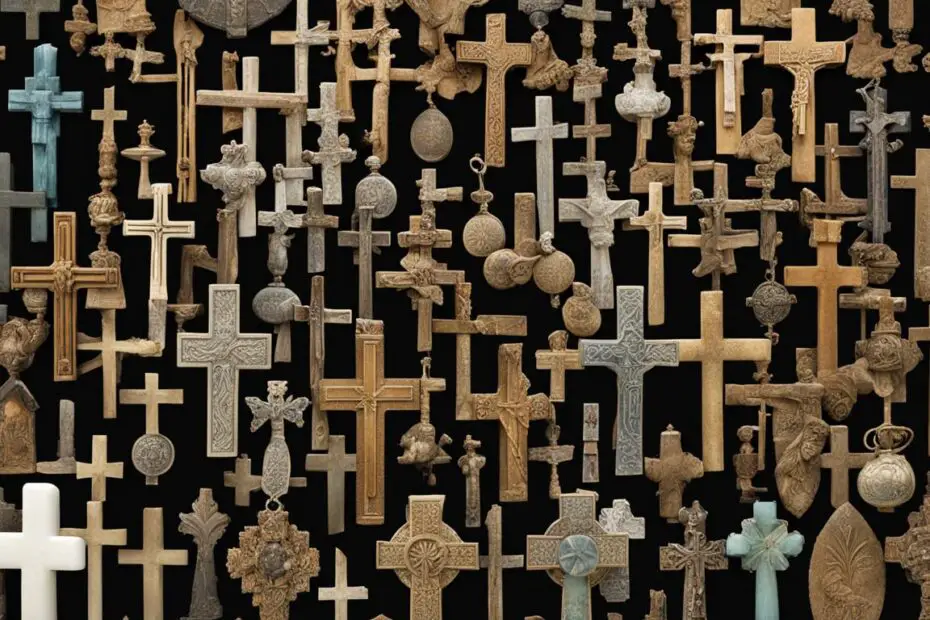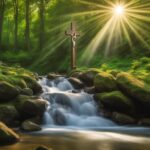The history of prayer crosses is a fascinating journey that spans centuries. These sacred symbols have deep roots in spiritual devotion, with origins dating back to ancient times. They hold deep significance in prayer practices and are infused with powerful symbolism. Let’s delve into the rich history of prayer crosses and explore their evolution as a fundamental tool in religious and spiritual traditions.
Key Takeaways:
- The history of prayer crosses dates back to ancient times and holds deep spiritual significance in prayer practices.
- Prayer crosses symbolize redemption, salvation, and the hope of eternal life.
- Throughout history, prayer crosses have evolved in form and style, reflecting the diverse expressions of faith and spirituality.
- Different cultures and regions have their unique traditions and practices associated with prayer crosses.
- Prayer crosses play a significant role in liturgical settings, inspiring reverence and deeper connections with the divine.
The Significance of Crosses in Prayer
Prayer crosses have long been recognized as powerful symbols in prayer. They serve as a visual reminder of the faith and devotion of believers. The cross is widely associated with the crucifixion of Jesus Christ and represents His sacrifice for humanity. In prayer, the cross symbolizes redemption, salvation, and the hope of eternal life. It serves as a focal point for meditation, contemplation, and connection with the divine.

The Symbolism of the Cross
The significance of the cross in prayer goes beyond its historical and religious associations. The cross is a universal symbol that transcends boundaries, representing love, compassion, and spiritual transformation. It embodies the belief that through prayer, individuals can find solace, guidance, and a deeper connection with a higher power.
The Cross as a Visual Reminder
Prayer crosses serve as tangible reminders of one’s faith and commitment to prayer. They can be worn as jewelry or held during prayer sessions, providing a physical anchor to focus the mind and heart. The presence of a prayer cross can evoke a sense of comfort, strength, and faith, allowing individuals to enter into a state of deep prayer and reflection.
The Cross as a Symbol of Hope
In times of difficulty and uncertainty, prayer crosses remind believers of the hope and strength that can be found in their faith. The cross represents the ultimate sacrifice and serves as a beacon of hope, assuring believers that they are never alone in their struggles. It serves as a source of inspiration and a symbol of unwavering faith.
“The cross is a reminder of Christ’s love and His eternal presence in our lives. Holding a prayer cross during prayerful moments creates a profound connection between the divine and the human spirit.”
Prayer Crosses as Tools for Meditation
Prayer crosses act as aids in meditation and contemplation. By focusing on the cross, individuals can quiet their minds and open their hearts to receive divine guidance and inspiration. The cross serves as a centering point, enabling believers to enter into a deeper state of prayer, leading to a heightened sense of spirituality and inner peace.
The Universal Appeal of Prayer Crosses
The significance of crosses in prayer extends across diverse religious and spiritual traditions. From Christianity to Islam, Buddhism to Hinduism, the cross as a symbol of prayer resonates with people worldwide. Its universal appeal lies in its ability to transcend cultural and linguistic barriers, connecting believers from different backgrounds through the shared experience of devotion and spiritual communion.
| Religious Tradition | Symbolism of Cross in Prayer |
|---|---|
| Christianity | The cross represents the sacrifice and resurrection of Jesus Christ and serves as a symbol of faith, redemption, and eternal life. |
| Islam | The cross, known as the “Sign of Tawhid,” symbolizes unity, oneness, and the presence of Allah in prayer. |
| Buddhism | The cross, known as the Dharma Wheel, represents the teachings of Buddha and the path to enlightenment. |
| Hinduism | The cross, known as the Swastika, symbolizes prosperity, good fortune, and auspiciousness in prayer. |
Evolution of Prayer Crosses Throughout History
Prayer crosses have evolved over time, taking on various forms and styles that reflect the cultural and religious contexts in which they were used. From ancient civilizations to modern times, the design and craftsmanship of prayer crosses have undergone remarkable transformations, reflecting the spiritual practices and beliefs of different eras.
In ancient civilizations, prayer crosses were simple wooden tools used in religious rituals and ceremonies. These crosses were often adorned with carved symbols or inscriptions, representing the beliefs and prayers of the individuals who used them. The primitive yet powerful nature of these prayer crosses highlights the deep spiritual significance they held in ancient cultures.
As Christianity spread and became a dominant religion, the use of crosses in prayer became more prevalent and elaborate. Prayer crosses began to incorporate fine craftsmanship and intricate designs, often made with precious metals, gemstones, and detailed engravings. These artifacts, discovered through archaeological excavations, provide us with valuable insights into the historical use of prayer crosses and their role in religious practices.
“The evolution of prayer crosses throughout history showcases the artistic ingenuity and the deep spiritual connection that humanity has had with these sacred symbols.”
These prayer crosses not only served as tools for prayer but also as tangible representations of faith and devotion. They were precious objects meant to be cherished and passed down through generations, serving as reminders of the spiritual heritage of their owners.
Today, prayer crosses continue to exist in various forms and styles, symbolizing the ongoing evolution of spirituality and personal expression. Whether as traditional wooden crosses or contemporary interpretations made with innovative materials, prayer crosses remain a vital aspect of religious and spiritual practices.
Through the evolution of prayer crosses, we honor the rich history and cultural significance embedded within these artifacts. They remind us of the enduring power of prayer and its ability to connect us with the divine.
The Evolution of Prayer Crosses Throughout History:
| Time Period | Form and Style | Material | Significance |
|---|---|---|---|
| Ancient Civilizations | Simple wooden crosses | Wood | Symbolic representation of devotion |
| Medieval Era | Elaborate designs with intricate engravings | Precious metals | Display of wealth and religious piety |
| Renaissance | Ornate and highly detailed crosses | Gold, silver, and gemstones | Exquisite craftsmanship and religious symbolism |
| Modern Era | Contemporary interpretations with innovative materials | Various | Expression of personal faith and spirituality |
Cultural and Regional Variations in Prayer Crosses
Prayer crosses have been embraced by diverse cultures and regions, each with their unique traditions and practices. These rich cultural and regional variations add depth and diversity to the history of prayer crosses, showcasing the wide-ranging expressions of faith and spirituality across different communities.
In some traditions, particular styles or materials are preferred when creating prayer crosses. For example, in the Ethiopian Orthodox Church, intricately carved wooden crosses are commonly used in prayer, reflecting the country’s rich artistic heritage. On the other hand, in Byzantine Orthodox tradition, prayer crosses are often adorned with gemstones and intricate engravings, showcasing the influence of the Byzantine Empire’s opulence.

Similarly, specific symbols or motifs hold significance in certain cultural and regional prayer crosses. In Ireland, the Celtic cross is a popular symbol, representing the fusion of Christianity with pagan Celtic elements. The intersection of the cross’s arms with the circle represents the harmony between the spiritual and natural worlds.
Table: Examples of Cultural and Regional Prayer Cross Variations
| Region | Cross Style | Symbols/Motifs |
|---|---|---|
| Ethiopia | Intricately carved wooden crosses | Geometric patterns, biblical scenes |
| Byzantine Empire | Precious metals, gemstones, intricate engravings | Icons of saints, Christ’s crucifixion |
| Ireland | Celtic cross | Knotwork, interlacing patterns |
| Mexico | Silver crosses, filigree work | Virgin Mary, traditional Mexican symbols |
These cultural and regional variations in prayer crosses reflect the diversity of beliefs, customs, and artistic traditions worldwide. They showcase the continual evolution and adaptation of prayer crosses within different communities, enriching the tapestry of prayer cross history.
Prayer Crosses in Liturgical Settings
Prayer crosses hold a sacred place in liturgical settings, such as churches and religious services. These symbols of faith are revered and prominently displayed on altars, acting as a focal point of worship and contemplation. Whether carried in processions or adorning the sanctuary, prayer crosses serve as tangible reminders of Christ’s presence and the deep connection believers seek during their spiritual journey.
When placed on altars, prayer crosses become visual anchors that draw the attention of worshippers. They symbolize the sacrificial love of Christ, inviting individuals to reflect on His teachings and the significance of the cross as a symbol of redemption. The liturgical use of prayer crosses creates an atmosphere of reverence, facilitating a deeper connection with the divine and encouraging the faithful to align their hearts and minds with the sacred rituals of prayer and worship.
Through the centuries, the liturgical use of prayer crosses has evolved, incorporating various designs, materials, and styles. From intricately carved wooden crosses to precious metal crucifixes adorned with gemstones, each offers a unique visual representation of devotion and spirituality. The choice of prayer crosses in liturgical settings may reflect the traditions and symbolism associated with specific religious denominations or cultural practices, enhancing the overall worship experience.
Let us explore the liturgical significance of prayer crosses further through an inspiring quote:
“The prayer cross, with its timeless presence, stands as a beacon of hope in the sanctuary, guiding the faithful towards deeper devotion and an intimate connection with the divine.”
Liturgical Use of Prayer Crosses
Prayer crosses in liturgical settings serve multiple purposes, each contributing to the overall worship experience:
- Visual Representation: The prayer cross visually represents the core beliefs and teachings of a faith tradition, ensuring a tangible symbol of devotion and spirituality. It serves as a reminder of the central tenets of faith and encourages individuals to engage deeply in prayer and contemplation.
- Focal Point of Worship: Placing prayer crosses on altars or carrying them in processions directs the focus of worshippers towards the sacred, offering a visual anchor during prayer and worship. They draw attention to the presence of Christ and invite individuals to connect with His teachings and sacrifice.
- Inspiration and Contemplation: Prayer crosses inspire deep reverence and contemplation, encouraging the faithful to reflect on their beliefs, actions, and the significance of the cross in their spiritual lives. They provide a physical representation of divine love and serve as a reminder of the eternal hope and redemption found in faith.
Let us explore the liturgical use of prayer crosses further through a visually engaging table:
| Prayer Cross Design | Denomination | Liturgical Significance |
|---|---|---|
 |
Catholic | The crucifix serves as a reminder of Christ’s sacrifice on the cross and the central focus of Catholic worship. |
 |
Orthodox | Iconic prayer crosses, displaying figures of saints and scenes from the life of Christ, evoke awe and devotion during Orthodox liturgical services. |
 |
Protestant | Simple and unadorned crosses in liturgical settings highlight the focus on Christ’s sacrifice and the importance of individual interpretation of faith. |
In the realm of liturgical worship, prayer crosses continue to inspire and guide believers in their spiritual journeys. Their presence on altars, in processions, and within symbolic rituals fosters an atmosphere of transcendence, inviting individuals to connect deeply with the divine presence and derive strength and solace from their faith.
Modern Interpretations and Contemporary Use of Prayer Crosses
In modern times, prayer crosses have evolved alongside changing styles and artistic expressions. Today, contemporary artists and craftsmen are creating prayer crosses that reflect the fusion of traditional symbolism and modern design. These modern interpretations breathe new life into this sacred symbol, allowing individuals to connect with their faith in contemporary ways.
Prayer crosses are crafted using a wide range of materials, including precious metals, gemstones, and even unconventional elements like glass or acrylic. This diversity of materials offers unique opportunities to explore different textures, colors, and visual effects in prayer cross designs.
Exploring Artistic Innovation in Prayer Cross Designs
Artists and craftsmen push the boundaries of traditional prayer cross designs, infusing them with fresh perspectives and artistic techniques. By blending traditional symbolism with contemporary aesthetics, these artists create prayer crosses that resonate with individuals seeking a deeper connection with their spirituality.
“Our contemporary prayer cross designs are an expression of our belief in the enduring power of prayer. We aim to create pieces that inspire a sense of reverence while also reflecting the beauty and complexity of the modern world.”
Contemporary prayer crosses may feature minimalist designs that emphasize simplicity and clean lines, making them suitable for everyday wear. On the other end of the spectrum, there are ornate and intricately crafted prayer crosses that captivate attention and serve as striking decorative pieces.
Utilizing Prayer Crosses for Meditation and Reflection
Prayer crosses have also found a place in meditation and spiritual practices. Their versatile nature allows individuals to use them as tools for focusing their thoughts and intentions during quiet moments of reflection. The physical act of holding a prayer cross can bring a sense of comfort and grounding, facilitating a deeper connection with one’s spiritual journey.
- Contemporary prayer crosses in meditation:
- Designed to be held during meditation sessions
- Smooth, rounded shapes for a soothing tactile experience
- Symbols or engravings that resonate with personal beliefs and intentions
- Contemporary prayer crosses in home decor:
- Elegant and visually captivating designs for display
- A variety of sizes to suit different spaces
- Materials that complement existing decor
The Intersection of Tradition and Innovation
Contemporary prayer crosses honor the significance of tradition while embracing the possibilities of modern design and cultural influences. They serve as reminders of the timeless power of prayer, connecting past, present, and future generations in a shared spiritual journey.
Incorporating a modern prayer cross into your spiritual practice can be a meaningful way to express your faith and connect with something greater than yourself. The diverse range of contemporary designs ensures that there is a prayer cross to suit every individual’s style and spiritual path.
The Enduring Symbolism of Prayer Crosses
The symbolism of prayer crosses has stood the test of time. Regardless of the specific design or cultural context, prayer crosses continue to represent faith, devotion, and the human longing for spiritual connection. The enduring symbolism of the cross as a universal symbol of love, sacrifice, and hope remains a cornerstone of prayer traditions across different religious and spiritual practices.
Throughout history, the cross has held profound meaning and significance. It serves as a powerful reminder of Christ’s sacrifice and love for humanity. The enduring symbolism of the cross resonates with believers, inspiring deep reverence and faith.
“The cross is a symbol of God’s love and compassion. It reminds us of His sacrifice and the eternal hope that springs forth from His resurrection. In prayer, the cross serves as a focal point, drawing us closer to God and affirming our faith in His unwavering presence.”
– Reverend James Williams
Prayer crosses have transcended religious boundaries, becoming a symbol of hope and spirituality for people around the world. Whether it’s the ornate Orthodox crosses, the simple wooden crosses of early Christianity, or the contemporary interpretations of prayer crosses, their enduring symbolism remains a constant source of inspiration and guidance.
When we hold a prayer cross in our hands, we are reminded of the eternal truths embedded within its symbol. It symbolizes the triumph of light over darkness, the power of love over hate, and the promise of redemption and salvation.
The Symbolism of the Cross in Different Cultures
The enduring symbolism of prayer crosses is not limited to a specific culture or religious tradition. In Christianity, the cross represents Christ’s sacrifice and victory over death. Similarly, in other faiths and spiritual practices, the cross holds symbolic significance.
- Hinduism: In Hinduism, the cross-like symbol known as the Swastika represents auspiciousness, prosperity, and well-being.
- Buddhism: The confluence of vertical and horizontal lines in the Buddhist cross, also known as the Dharmachakra, symbolizes the Noble Eightfold Path, the essence of Buddha’s teachings.
- Native American Spirituality: The Native American Medicine Wheel incorporates the cross-like shape, representing the interconnectedness of all life and the four cardinal directions.
- Ancient Egyptian Religion: The Ankh, an ancient Egyptian cross-like symbol, represents life and divine protection, often associated with gods and goddesses.
The enduring symbolism of prayer crosses transcends cultural and religious boundaries, serving as a powerful reminder of the human quest for transcendence, peace, and spiritual fulfillment.
Preservation and Appreciation of Prayer Cross History
Prayer crosses hold immense historical and cultural value, making it imperative to preserve and appreciate their significance. Museums, religious institutions, and collectors play a crucial role in recognizing the importance of prayer cross artifacts. Exhibitions and educational programs are organized to showcase these precious pieces, allowing individuals to engage with and learn from the rich history they represent.
By studying and appreciating prayer cross history, we deepen our understanding of the profound role these symbols have played in shaping religious practices and beliefs. The preservation of prayer cross artifacts allows future generations to connect with the spirituality and devotion of our ancestors, providing valuable insights into the universal human yearning for a higher power.
Recognizing the significance of prayer cross history also entails acknowledging the craftsmanship and artistic expression that went into creating these precious artifacts. From the intricate designs to the meticulous attention to detail, each prayer cross tells a unique story of faith and reverence.
“The history of prayer crosses is a testament to the enduring power of the cross as a symbol of devotion, redemption, and the eternal hope that resonates across diverse cultures and faith traditions.”
The Role of Museums in Preserving and Promoting Prayer Cross Artifacts
Museums play a pivotal role in preserving and promoting prayer cross artifacts. They act as custodians of history, safeguarding these valuable objects and ensuring their longevity. Exhibitions and curated displays provide a platform for prayer crosses to be appreciated by the public, fostering a deeper understanding and connection to the past.
Through interactive exhibits, guided tours, and educational programs, museums offer visitors the opportunity to engage with prayer cross history on a personal and intellectual level. They provide a space for contemplation and reflection, inviting individuals to explore the symbolism and profound meaning encapsulated within these remarkable artifacts.
The Significance of Collectors in Safeguarding Prayer Cross Artifacts
Collectors also play a vital role in preserving prayer cross artifacts. Their passion for these sacred objects drives them to seek out, acquire, and maintain prayer cross collections. By carefully curating these collections, collectors ensure that the artifacts are protected and accessible for future generations to appreciate and study.
These meticulously maintained collections often provide invaluable resources for researchers, historians, and curators. They offer insights into the historical context, craftsmanship techniques, and stylistic variations of prayer crosses, contributing to a more comprehensive understanding of their significance.
Appreciating the Historical and Cultural Significance of Prayer Crosses
The preservation and appreciation of prayer cross history allow us to recognize the indelible mark these symbols have left on religious practices and beliefs. They serve as a tangible connection to the past, illuminating the enduring power of faith and the human quest for spiritual fulfillment.
In appreciating prayer cross history, we acknowledge the shared heritage and universal aspirations that unite us as a global community. Through education, exhibition, and collective appreciation, we ensure that the legacy of prayer cross artifacts endures for generations to come.
| Benefits of Preservation and Appreciation | Preservation Efforts | Appreciation Initiatives |
|---|---|---|
| 1. Deepens understanding of religious practices and beliefs. | 1. Museum exhibitions and programs. | 1. Curated collections by collectors. |
| 2. Connects with the spirituality of ancestors. | 2. Conservation and restoration efforts by experts. | 2. Educational programs and guided tours in museums. |
| 3. Showcases the craftsmanship and artistic expression of prayer crosses. | 3. Collaboration between museums and religious institutions. | 3. Interactive exhibits for public engagement. |
Conclusion
The rich history of prayer crosses reveals their profound significance in spiritual devotion throughout the ages. These sacred symbols, with their origins rooted in ancient times, continue to inspire and facilitate prayer and contemplation. As we explore the layers of symbolism and meaning intertwined in prayer crosses, we develop a deeper understanding of the interplay between faith, history, and spirituality.
From ancient wooden crosses to contemporary interpretations, prayer crosses have been cherished by countless individuals and communities across diverse cultures and faith traditions. The cross, as a symbol of devotion, redemption, and eternal hope, holds a timeless power that resonates with people seeking spiritual connection and solace.
As we reflect on the history of prayer crosses, we acknowledge the enduring significance they hold in religious and spiritual practices. They serve as reminders of faith and devotion, encapsulating the sacrifice and redemption symbolized by the crucifixion of Jesus Christ. The prayer cross stands as a focal point for meditation, contemplation, and an invitation to connect with the divine.
In our exploration of prayer cross history, we appreciate the valuable role these sacred symbols have played in shaping religious beliefs and practices. From ancient artifacts to contemporary designs, prayer crosses continue to be preserved and celebrated in museums, religious institutions, and private collections. They serve as tangible links to a rich spiritual heritage that inspires contemporary believers in their prayer journey and fosters a deeper connection to their faith.
FAQ
What is the history of prayer crosses?
The history of prayer crosses dates back to ancient times, with their origins deeply rooted in spiritual devotion. They have evolved over the centuries and serve as powerful symbols in prayer practices.
What is the significance of crosses in prayer?
Crosses hold deep significance in prayer, symbolizing redemption, salvation, and the hope of eternal life. They serve as a focal point for meditation, contemplation, and connection with the divine.
How have prayer crosses evolved throughout history?
Prayer crosses have taken various forms and styles over time. From simple wooden crosses in ancient civilizations to elaborate designs with precious metals and engravings, prayer crosses have seen an evolution in their craftsmanship and symbolism.
Are there cultural and regional variations in prayer crosses?
Yes, prayer crosses have been embraced by diverse cultures and regions, each with their unique traditions and practices. Different styles, materials, symbols, and motifs may be incorporated, reflecting the expressions of faith and spirituality in different communities.
How are prayer crosses used in liturgical settings?
Prayer crosses play a significant role in liturgical settings, such as churches and religious services. They are prominently displayed on altars or carried in processions, serving as symbols of Christ’s presence and the central focus of worship.
How are prayer crosses used in modern times?
Prayer crosses continue to be cherished and used in various forms, from traditional designs to contemporary interpretations. They can be worn as personal accessories, displayed as decorative items, or used as tools for meditation and prayer.
What is the enduring symbolism of prayer crosses?
Regardless of the specific design or cultural context, prayer crosses continue to represent faith, devotion, and the human longing for spiritual connection. They symbolize love, sacrifice, and hope, remaining a cornerstone of prayer traditions across different religious and spiritual practices.
How is the history of prayer crosses preserved and appreciated?
Museums, religious institutions, and collectors recognize the importance of prayer cross artifacts and showcase them in exhibitions and educational programs. The study and appreciation of prayer cross history deepen our understanding of their significance in shaping religious practices and beliefs.
What is the conclusion about the history and symbolism of prayer crosses?
The history of prayer crosses is a testament to their enduring power as symbols of devotion, redemption, and eternal hope. They hold immense cultural and historical value and continue to inspire prayer and contemplation across different faith traditions.









